Navigate the intricate world of fashionable fabrics with our expert comparison of durability, comfort, and style applications
Lace and mesh fabrics may look similar at first glance, but they have distinct characteristics that set them apart. Mesh fabric is made from thin plain weave with fine twisted yarn, while lace features intricate patterns and designs created through complex weaving or knitting techniques.
Lace fabric can be either stretch or non-stretch, offering unique properties in terms of drape, feel, and visual appeal. Each type brings its own charm to clothing and decorative items, with mesh known for its breathability and lace celebrated for its ornate beauty.
These fabrics serve different purposes in fashion and home décor. Mesh provides lightweight coverage and ventilation, making it ideal for sportswear and functional items. Lace adds elegance and sophistication to special occasion wear and decorative pieces.
On This Page
Key Takeaways
- Mesh offers superior breathability with its simple, open weave structure
- Lace creates decorative patterns through complex weaving techniques
- Both fabrics come in varying weights and stretches for different uses
History and Evolution
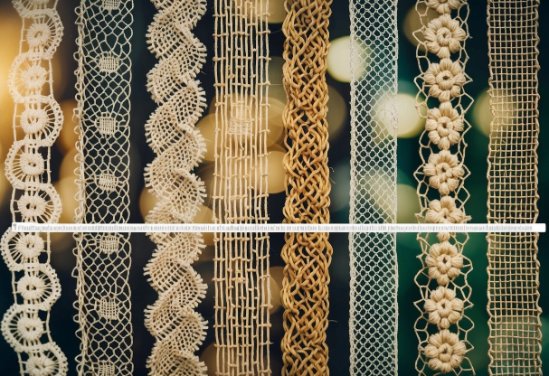
Lace and mesh emerged through distinct paths in textile history, with lace starting as a luxury handcraft and mesh developing from practical needs in clothing and industry.
Origins of Lace
Lace-making began in Italy during the late 1500s, with two primary techniques emerging: needle lace and bobbin lace. These methods required immense skill and patience.
Needle lace artisans created intricate patterns using a single needle and thread, whilst bobbin lace makers wove multiple threads wound on wooden bobbins.
Italian craftspeople developed sophisticated patterns during the 17th century, including the raised Gros Point and flowing Milanese styles.
Development of Mesh Materials
Early mesh appeared in traditional lace patterns as irregular, dense backgrounds. The structure evolved to become more open and uniform over time.
The Industrial Revolution transformed mesh production. Machine-made mesh replaced handwoven varieties, making the material more accessible and affordable.
English manufacturers incorporated regional motifs like the Tudor rose into their designs, creating distinctive patterns that combined mesh backgrounds with decorative elements.
Before 1800, craftspeople primarily used linen threads for both lace and mesh creation. Later, manufacturers introduced new materials like cotton and synthetic fibres.
Material Composition
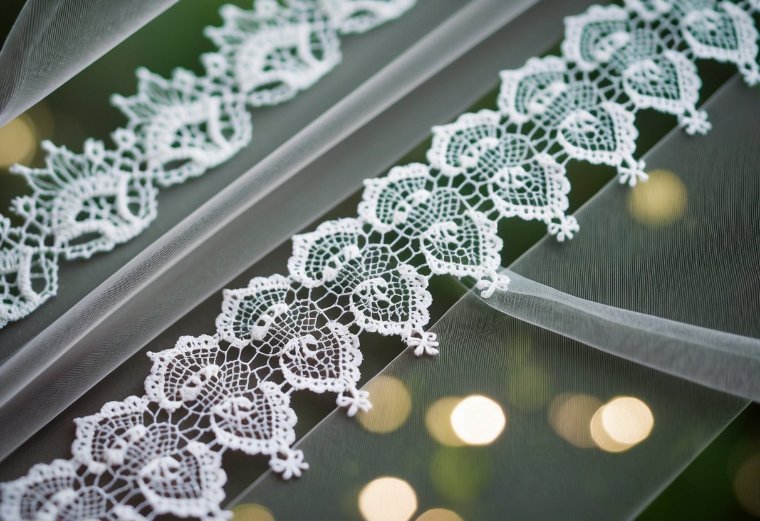
The key differences between lace and mesh fabrics lie in their fibre content and construction methods, which directly impact their properties and uses in clothing.
Natural Fibres in Lace
Traditional lace fabric uses cotton threads as its primary natural fibre component. Cotton lends a soft, breathable quality to lace garments and accessories.
Natural silk fibres create premium lace varieties with distinctive sheen and drape. These delicate threads produce intricate patterns ideal for special occasion wear.
The ground pattern in cotton lace features small, even spaces between thread intersections. This creates the characteristic open weave that defines quality lace pieces.
Synthetic Fibres in Mesh
Modern mesh fabric typically contains 90% nylon and 10% spandex. This blend provides strength and stretch.
Non-stretch mesh varieties use 100% nylon construction. The synthetic fibres create a durable, lightweight material.
Common Mesh Fabric Compositions:
- Nylon-spandex blend for stretch mesh
- Pure nylon for rigid mesh
- Polyester-based mesh for sportswear
Synthetic mesh offers excellent moisture-wicking properties and maintains its shape through repeated wear and washing.
Fabric Characteristics
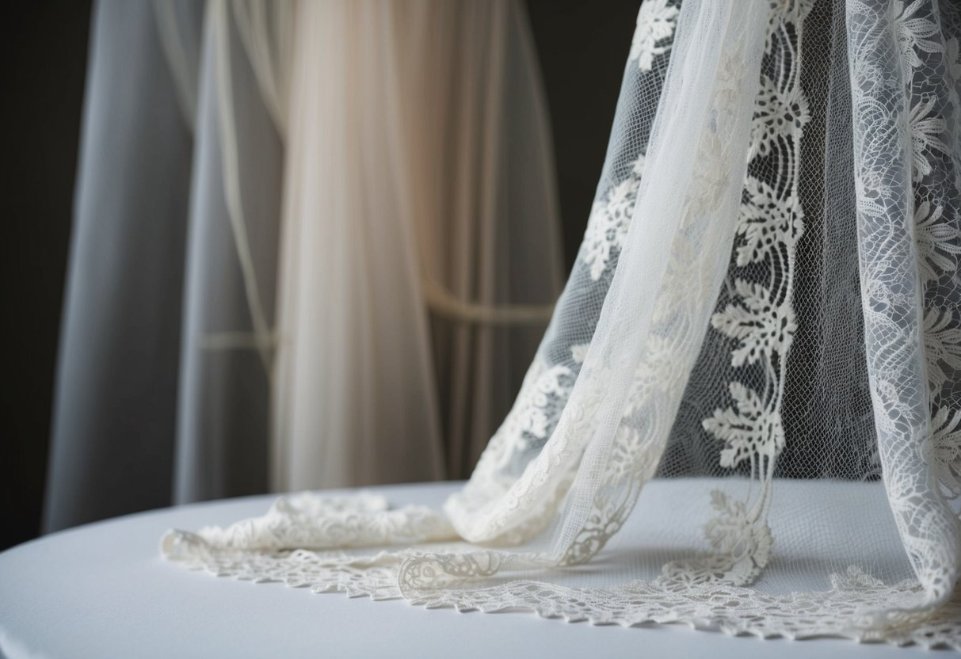
Both lace and mesh fabrics offer distinct physical properties that make them suitable for different applications in fashion and textiles. Each type brings unique structural elements that affect their performance and uses.
Lace: Delicacy and Elegance
Lace fabric features intricate patterns and delicate designs created through complex weaving or knitting techniques. The fabric composition typically includes 90% nylon and 10% spandex for stretch varieties, whilst non-stretch lace uses 100% nylon.
The material’s lightweight structure allows excellent breathability, making it ideal for formal wear and intimate apparel. Its sheerness varies based on the pattern density and yarn thickness.
Traditional lace displays remarkable durability despite its delicate appearance, though it requires gentle handling during washing and wear. The fabric’s strength comes from its interconnected pattern structure.
Mesh: Durability and Versatility
Mesh fabric construction consists of fine, twisted yarns woven in an open pattern with clear, defined holes. This creates a strong yet flexible material.
The fabric offers superior breathability due to its open structure. Its transparency level varies based on hole size and yarn thickness.
Mesh delivers excellent strength and resilience, making it suitable for sportswear and protective gear. The material maintains its shape well and resists tearing.
Its lightweight nature and high air permeability make mesh extremely comfortable for extended wear. The fabric dries quickly and provides good ventilation.
Fashion and Apparel
Lace and mesh fabrics serve distinct roles in modern clothing design. Nylon-spandex blends create comfortable and durable garments, whilst each material brings unique aesthetic and functional qualities to different fashion categories.
Lace in High Fashion and Bridal Wear
Lace dominates formal and celebratory fashion with its ornate patterns and luxurious appearance. Bridal gowns often feature French or Chantilly lace overlays, creating timeless elegance.
Designer collections regularly showcase lace in evening wear and cocktail dresses. The material adds sophistication to formal skirts and blouses.
In lingerie, high-quality nylon-blend lace offers both beauty and comfort. Women’s underwear collections utilise stretch lace for better fit and movement.
Mesh in Sportswear and Casual Clothing
Cotton mesh fabric dominates athletic wear due to its superior breathability and moisture-wicking properties. Sports jerseys and training tops incorporate mesh panels for ventilation.
Casual fashion embraces mesh in t-shirts and summer dresses. The material provides lightweight comfort in warm weather.
Modern activewear combines mesh with compression fabrics for enhanced performance. Strategic mesh placement in workout gear helps regulate body temperature.
Fashion brands use mesh inserts in casual tops and skirts to create visual interest whilst maintaining comfort.
Decorative Uses
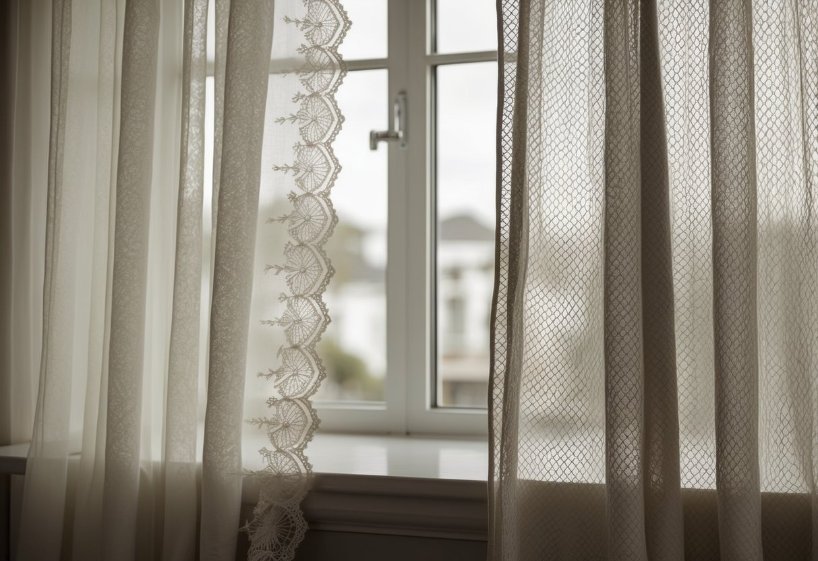
Both lace and mesh add visual interest and texture to interior spaces through their distinctive patterns and transparency. Each material brings unique aesthetic qualities that enhance different decorative applications.
Lace Embellishments in Home Décor
Intricate lace patterns create an elegant, romantic atmosphere in home settings. Vintage-style curtains with delicate floral motifs filter sunlight whilst adding a graceful touch to windows.
Layering lace over solid fabrics produces sophisticated effects on cushions and table linens. The material’s refined details work beautifully for:
- Lampshade overlays
- Decorative table runners
- Bed canopies
- Dressing table scarves
Mesh Applications in Interior Design
Modern mesh materials offer clean lines and contemporary styling options. Their geometric patterns create striking visual effects through light and shadow play.
Mesh works brilliantly in:
- Room dividers
- Window treatments
- Decorative screens
- Light fixture covers
The open weave structure allows excellent airflow whilst maintaining privacy. Metallic mesh adds industrial chic to modern spaces, creating dramatic backdrops for artwork or serving as sculptural wall features.
Types and Techniques
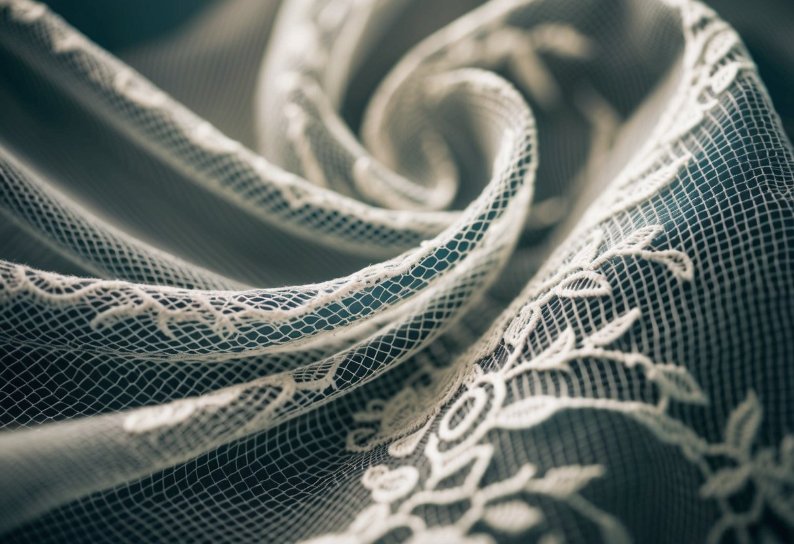
Lace and mesh fabrics each have distinct manufacturing methods and characteristics that create their unique appearances. Traditional lace-making involves intricate handwork or machine processes, whilst mesh relies on specific weaving or knitting techniques.
Varieties of Lace
Chantilly lace features delicate floral patterns on fine mesh backgrounds, making it popular for bridal wear and formal attire.
Venetian lace stands out with its raised designs and lacks a mesh backing, creating standalone motifs through a unique dissolving fabric process.
Alençon lace showcases intricate patterns with corded outlines and detailed needlework. This royal French lace often incorporates small beads or sequins.
Guipure lace has a bold, textured appearance with connected motifs and no backing net. Its sturdy construction makes it ideal for structured garments.
Mesh Weaving Methods
Power mesh uses stretchy synthetic fibres in a fine, tight weave. Its strong recovery and support make it essential for shapewear and athletic clothing.
Polyester mesh comes in various weights and hole sizes. Fine mesh offers gentle filtering or lining, whilst larger holes provide ventilation in sportswear.
Tulle creates a lightweight, hexagonal net pattern through twisted yarns. This versatile mesh appears in everything from ballet tutus to wedding veils.
Voile mesh has a soft, semi-sheer quality from its plain weave construction. Its smooth texture works well for overlays and lightweight curtains.
Specialised Fabrics
Different fabric types serve unique purposes in garment construction, with each material offering distinct advantages in flexibility and visual appeal.
Performance Fabrics: Stretch and Compression
Elastic lace fabric typically contains 90% nylon and 10% spandex, creating excellent stretch and recovery properties.
Non-stretch lace, made from 100% nylon, provides structure and stability in formal garments.
Stretch lace adapts to body movement, making it ideal for:
- Dance costumes
- Athletic wear
- Form-fitting garments
- Swimwear
Tulle fabric comes in various weights and stiffness levels, with fine tulle offering delicate drape and sturdy tulle providing structure.
Elevated Aesthetics: Embroidered and Patterned Designs
Allover lace creates intricate patterns that enhance the visual appeal of garments.
Bali yarn and glass yarn produce distinctive textures in lace designs, adding depth and character to the fabric surface.
Common pattern styles include:
- Floral motifs
- Geometric designs
- Scalloped edges
- Abstract patterns
The density and complexity of patterns affect both the fabric’s appearance and its performance characteristics. Fine patterns create subtle texture, whilst bold designs make dramatic statements.
Care and Maintenance
Both lace and mesh fabrics need gentle care to maintain their quality. Handwashing is the safest method for cleaning these delicate materials, using cool water and mild soap.
Machine washing can damage delicate laces and meshes. If machine washing is necessary, use a mesh laundry bag and select the gentle cycle with cold water.
Lace requires extra gentle handling during washing and drying. Never wring or twist lace items, as this can stretch and distort the patterns.
Air drying is essential for both materials. Lay items flat on a clean towel away from direct sunlight to prevent fading and fabric damage.
Natural fibre laces and meshes may shrink or lose shape if exposed to heat. Keep these items away from radiators and heated surfaces.
Storage is crucial for longevity. Store lace and mesh items flat in drawers or hang them carefully to avoid snags and tears.
The life span of these materials varies greatly. Synthetic mesh typically lasts longer than natural fibres, especially with proper care and maintenance.
Care Tips:
- Use mild detergents only
- Avoid fabric softeners
- Never bleach
- Iron on low heat if needed
- Store in cool, dry places
Frequently Asked Questions
Textiles like lace and mesh serve distinct purposes in fashion, with each material offering unique properties for specific garment applications. The manufacturing methods, fibre content, and structural characteristics create notable differences in their appearance and functionality.
What distinguishes lace fabric from mesh material in clothing design?
Lace fabrics feature intricate patterns and decorative elements woven into their structure, whilst mesh maintains a simple, uniform grid pattern.
Lace composition typically contains 90% nylon and 10% spandex for stretch varieties, or 100% nylon for non-stretch options.
How do the properties of mesh fabric compare to those of lace when used in undergarments?
Mesh provides superior breathability and moisture-wicking capabilities due to its open-knit structure.
Lace offers more decorative possibilities and often features a softer hand feel against the skin.
Can mesh be considered a type of lace, and what are the criteria for differentiation?
Mesh and lace are both open-weave fabrics, but they differ in construction and purpose.
Lace requires complex pattern-making techniques, whilst mesh uses a simple, regular grid structure.
In terms of fashion and functionality, what are the benefits of using mesh over sheer materials?
Mesh fabric provides better durability and structure compared to traditional sheer materials.
The uniform holes in mesh allow for controlled ventilation and support in athletic wear.
What factors influence the quality perception of mesh fabrics in the textile industry?
The fineness of the grid pattern and the consistency of the holes affect mesh quality significantly.
Fibre content and manufacturing precision determine the fabric’s stretch recovery and durability.
How does the construction of net fabrics differ from that of lace in garment manufacturing?
Net fabrics use a simple knotted or woven construction to create uniform openings.
The manufacturing process for lace requires specialised machinery to create complex patterns and motifs.

